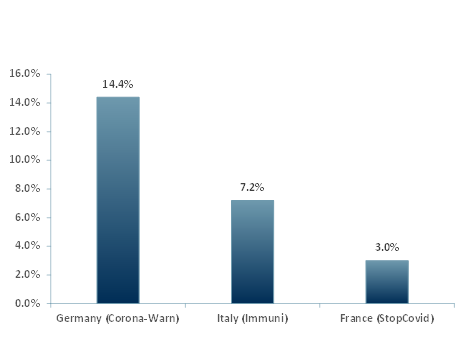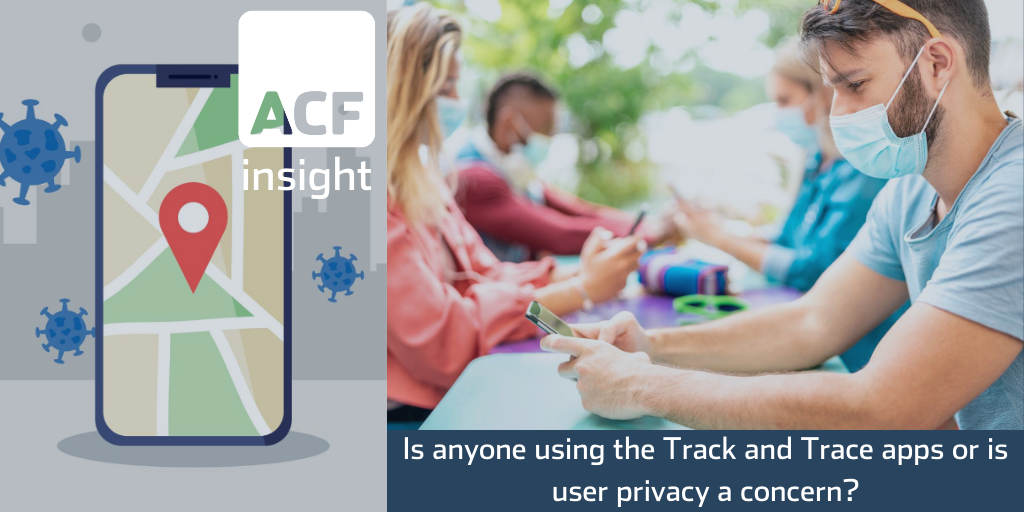Europeans aren’t really using Covid-19 contact-tracing apps
12 out of the 28 European countries have released Covid-19 tracing apps in June 2020, however it seems that no one is using them.
Exhibit 1 – EU Covid-19 Tracing app usage

Source: ACF Equity Research, VICE
Germany’s Corona-Warn app is only used by 14.4% of the total population of 83m. Italy’s Immuni is being used by 7.2% (pop. 60m) and France’s StopCovid by a mere 3% (pop. 67m). The assumption is that as lockdown restrictions ease many individuals are taking a more complacent attitude towards the virus. This is unsettling as some countries have not yet hit a peak of the first wave and others are on their way to a second wave. Globally the first wave of infections continues to pick up pace.
Spain reported 971 new cases in just one day on Thursday 23 July 2020. A government virus expert indicated that in just two weeks the country’s rate of infection rose three times. Spain has a tracing app called ‘Radar Covid’ and the final phase of testing began just last week on 20 July 2020. Results on reliability of track and trace are still pending.
Prof. Dirk Brockmann, a researcher from the Robert Koch Institute says that the trace apps are exponentially ‘less effective’ for each individual not using it. Prof. Dirk observes the relationship between coverage (% of users using the app) X and encounters (how individuals are actually connected) Y.
Y = X^2
For example, if only 10% of the population have the app (X=10%) then only 10% of their contacts are also using the app. This equates to a rate of transmissions being detected of 1%, 99% are undetected. Y=10%^2=1%.
Exhibit 2 – Covid-19 tracing apps’ efficacy improves exponentially with user adoption growth

Source: ACF Equity Research
The chart describes how the higher the percentage of users the greater the efficacy of a Covid tracing app. It is all the more important that these applications can function easily, efficiently and in a way that consumers will feel more comfortable using them knowing that their data is not being used for other purposes.
Privacy concerns are real amongst the public – the publics’ trust in IT’s ability to protect their privacy, Companies’ integrity and the ability of government departments to resist making specious ‘exceptions’ post the fact, has been eroded.
There are also operational reliability questions. In June, the UK’s NHS Covid-19 tracing app ‘NHSX’ had to be abandoned after a failed government launch attempt.
The NHSX example speaks to the fact that governments should not always intervene in areas where they may not have the expertise or credentials and should leave as many matters as they can to the private sector. In the end the privacy questions are similar – government or corporate – but corporates do a better job of efficiency due to the profit incentive, more often that governments.
The public sector should be there to support the private sector whether it is via regulations, development, or financing. This can in-turn improve capital markets by providing resources or creating a market framework for private companies to carry out their current business activities or expand into new ones.
Governments can also ease concerns around data privacy issues by implementing stricter regulations around data that is collected – and then respect those restrictions themselves. This is key as we enter into the next normal post-Covid, which is increasingly tech heavy. i.e. tracing apps, telemedicine, telehealth, etc.
As lockdown restrictions ease, a rise in complacency amongst the general populace is inevitable, however a simple review of pandemic history tells us we are not near a Covid-19 conclusion.
The use of tracing apps is a critical part of the armoury in order to contain the virus and avoid further lockdown events.
But first the efficiency of the tracing apps and operational system needs to improve in order that the efficacy can improve and in between the two a change of behaviour is needed in the population – worryingly, that usually takes a generation.
















